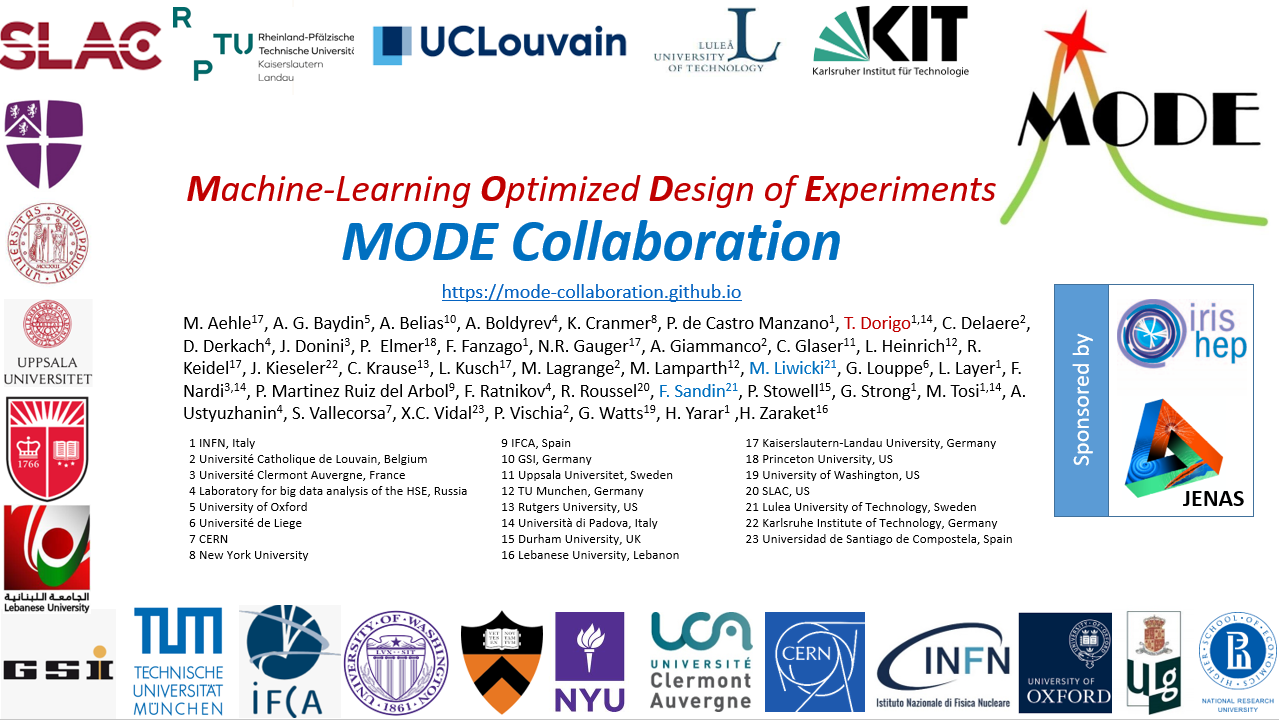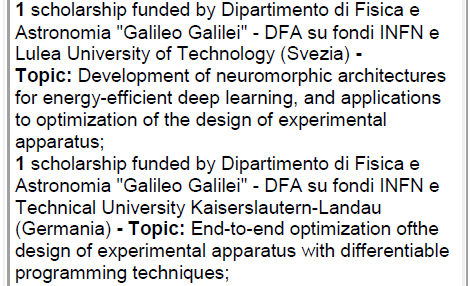University of Padova is an important centre for academic studies in Italy. It is the third oldest university in the world, and just turned 800 years old! The department of Physics and Astronomy itself has been selected for 2023-27 as a centre of excellence. And Padova is a very pleasant small town in north-eastern Italy, where over 70,000 students receive education in all fields of sciences and humanities.
The University has a unified call for all subjects, and within the call there are 44 positions for a PhD in physics. This is a rather large number, which should guarantee a significant rate of success for applicants passing the minimum admission criteria.
You can find all the information at these two links:
- this one (which points to the three documents to be downloaded, direct link here)
- and this one , which is from the Physics department and includes a video, and more information.
The positions are of two kinds: there are 13 "open" ones, which allow winners to freely decide what research topic to embark on and what supervisor to choose among the full body of staff members at the Department of Physics and the personnel of research institutes (e.g. INFN) in Padova. And then there is a large number of positions that target specific research topics. If you apply for a Phd in Physics, you need to be careful to "opt in" to the positions you may be happy to get, and not opt in to ones you would not want. In fact, the selection procedure is a bit baroque, and depending on what you do and do not tick, you may gain or lose the chance to be offered some of the 44 positions.
This year I invested some funds to offer a couple of joint PhD positions which are in the list. These two positions are "special" in the sense that they imply:
- a co-tutorship by me and a computer scientist from a different University
- the spending of 18 months in Padova and 18 months at the foreign University with the computer scientist tutor's research team
- the increase of the salary by 50% for the 18 months spent outside Italy
- the embedding of the winning candidates in the MODE collaboration (boosting their visibility and networking chances).
As for MODE, here is a defining slide for the collaboration (link: https://mode-collaboration.github.io).

Of additional interest is the fact that besides the allocated funds for travel to external schools that the student will be endowed with as part of the PhD program in Padova, I will make additional funding available to the students, and specifically encourage them to participate in a rich training program, with attendance to international events (Ph.D. schools in physics, computing, machine learning) and conferences, and stays at foreign institutes.
The snapshot below shows where the two positions are listed in the document available at the link provided above.

The two positions, while being in a sense related to work at the crossroads of physics and computer science, are still going to produce a title of Ph.D. in Physics. And they both involve the participation of candidates to the MODE collaboration, which is a group of physicists and computer scientists from 24 institutes around the world, who work together to solve difficult problems of end-to-end optimization for fundamental science applications (see https://mode-collaboration.github.io . I founded the MODE collaboration in 2020 and have been directing it since).
Lulea, Sweden
The first position is meant for applicants who will be jointly supervised by myself and by Prof. Fredrik Sandin. Fredrik is a full professor at the Computer Science department of Lulea Technical University. A physicist by background, he is an expert in neuromorphic computing, a topic about which I will discuss in a post in this blog very soon (I will put here a link when I write that piece).
In a nutshell, neuromorphic computing exploits the time-encoding of information in streams of "spikes", signals that travel to the synapse of neurons and produce changes in the membrane potential, activating an output signal. The time encoding allows for extreme reduction in power consumption with respect to normal digital computing, and the strength of the connection between synapses and neurons acts as a in-place memory storage, so that neuromorphic computing allows for co-location of memory and computing, avoiding the problem of data communication between storage and CPU normally seen in digital processors. NC is particularly exciting since it is a much more accurate model of the working of our brain, and offers applications in edge computing applications (such as the internet of things). Of high relevance is the energy efficiency of these devices, looking at the green transition.
The position we offer is for a graduate student who will work at applications of neuromorphic computing for fundamental science. This is a broad definition, and indeed although we have a couple of specific applications in mind, we will be able to adapt the work plan to the student's wishes. One possibility involves developing a triggering and processing strategy for radio antennas detecting the signal of neutrino interactions in the ice of the Arctic, in collaboration with another group of physicists from the University of Uppsala. In any case, the student will be embedded in the MODE collaboration and she or he will benefit from the rich program of activities we are carrying out within that group.
Kaiserslautern, Germany
The second position offers research work in collaboration with the RPTU University in Kaiserslautern, with as co-supervisor Prof. Nicolas R. Gauger. Nicolas is the chairholder for Scientific computing and director of the computing center RHRZ in Kaiserslautern-Landau. He has enormous competence in scientific computing and outstanding track record of teaching and advisorship.
In this case the research work is centered on optimization of particle physics detectors, and again the exact definition of the work is voluntarily left open to finalization according to the preferences of the winning candidate. One possibility is to study the development of highly granular hadron calorimeters for future particle colliders, when the integration with a tracker may provide a paradigm change with respect to current available technologies, looking forward to providing particle-ID capability in these instruments.
More information
If you need more information on these positions, and/or want to chat with me on the topic, I will make available a couple of slots for zoom meetings where I can answer all your questions. Just fill a when2meet poll here (use your email as your name, so I can identify you!, and possibly send me an email (at tommaso.dorigo(at)gmail(dot)com) about it too) to indicate the dates/times you prefer, and I will try to meet all demands! But be careful to indicate _all_ the time slots you can possibly make, as I need to then pick a couple of dates/times that maximize demand. Good luck!





Comments